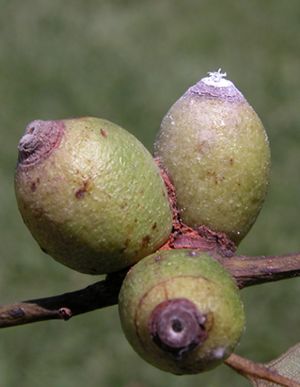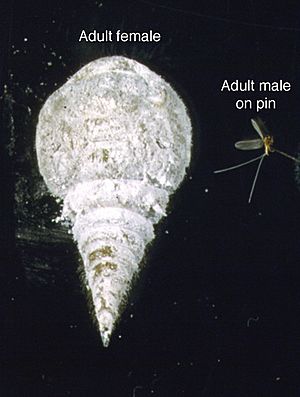Apiomorpha facts for kids
Quick facts for kids Apiomorpha |
|
|---|---|
 |
|
| Apiomorpha conica galls of 3 adult females. |
|
| Scientific classification | |
| Kingdom: | |
| Phylum: | |
| Class: | |
| Order: | |
| Suborder: |
Sternorrhyncha
|
| Superfamily: | |
| Family: |
Eriococcidae
|
| Genus: |
Apiomorpha
Rübsaamen
|
| species | |
|
See text |
|
Apiomorpha is a group of tiny insects called scale insects. These insects create special growths called galls on Eucalyptus trees. Think of galls as unique homes or shelters the insects make on the plant.
These galls start forming when very young Apiomorpha insects, called crawlers, settle on new plant shoots. As the insects grow, their galls also grow. The galls made by female Apiomorpha insects look very different from those made by males. This difference is called sexual dimorphism. Female galls can be quite large and amazing to see, while male galls are usually small and shaped like tubes.
Apiomorpha insects are found only in Australia and New Guinea. However, their host trees, Eucalyptus, grow in more places, including Indonesia. Apiomorpha is currently part of the Eriococcidae family.
What They Look Like
Like other scale insects, Apiomorpha insects show a big difference between males and females. This is called sexual dimorphism.
Female Apiomorpha
Adult female Apiomorpha insects do not have wings. They have very small eyes, or sometimes no eyes at all. Their legs are short and thick. A female stays inside the gall she started building when she was a tiny crawler. She mates through a small opening at the top of her gall.
She also lays her eggs and raises her babies inside the gall. Her tiny offspring, which are less than 0.4 mm long, leave the gall through the same small opening. Adult female Apiomorpha can be from 2 mm to 45 mm long. Their size depends on the specific species. Some females can live for up to five years as adults.
Male Apiomorpha
In contrast, adult male Apiomorpha insects are small, usually about 1 mm long. They have wings, which females do not. Unlike the females, male Apiomorpha do not have mouths. This means they cannot eat once they become adults.
Instead, they have an extra pair of eyes on the underside of their head. So, they have four eyes in total: two on top and two underneath. Males leave their galls when they are adults. They then search for females to mate with. They are not very strong fliers. They often walk on the host plant looking for females before they fly. After leaving their gall, adult males usually live for only about one day.
Species of Apiomorpha
There are many different species within the Apiomorpha group. Each species might create slightly different looking galls. Here are some of the known species:
- Apiomorpha amarooensis
- Apiomorpha annulata
- Apiomorpha attenuate
- Apiomorpha baeuerleni
- Apiomorpha calycina
- Apiomorpha conica
- Apiomorpha cucurbita
- Apiomorpha densispinosa
- Apiomorpha dipsaciformis
- Apiomorpha duplex
- Apiomorpha excupula
- Apiomorpha floralis
- Apiomorpha frenchi
- Apiomorpha gongylocarpae
- Apiomorpha gullanae
- Apiomorpha helmsii
- Apiomorpha hilli
- Apiomorpha intermedia
- Apiomorpha jucundacrispi
- Apiomorpha karschi
- Apiomorpha longiloba
- Apiomorpha macqueeni
- Apiomorpha maliformis
- Apiomorpha malleeacola
- Apiomorpha munita
- Apiomorpha nookara
- Apiomorpha ovicola
- Apiomorpha ovicoloides
- Apiomorpha pedunculata
- Apiomorpha pharetrata
- Apiomorpha pileata (type species)
- Apiomorpha pomaphora
- Apiomorpha regularis
- Apiomorpha rosaeformis
- Apiomorpha sessilis
- Apiomorpha sloanei
- Apiomorpha spinifer
- Apiomorpha strombylosa
- Apiomorpha subconica
- Apiomorpha tepperi
- Apiomorpha thorntoni
- Apiomorpha urnalis
- Apiomorpha variabilis
- Apiomorpha withersi


